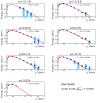Evidence of isospin-symmetry violation in high-energy collisions of atomic nuclei
- PMID: 40122858
- PMCID: PMC11930989
- DOI: 10.1038/s41467-025-57234-6
Evidence of isospin-symmetry violation in high-energy collisions of atomic nuclei
Abstract
Strong interactions preserve an approximate isospin symmetry between up (u) and down (d) quarks, part of the more general flavor symmetry. In the case of K meson production, if this isospin symmetry were exact, it would result in equal numbers of charged (K+ and K-) and neutral (K0 and ) mesons produced in collisions of isospin-symmetric atomic nuclei. Here, we report results on the relative abundance of charged over neutral K meson production in argon and scandium nuclei collisions at a center-of-mass energy of 11.9 GeV per nucleon pair. We find that the production of K+ and K- mesons at mid-rapidity is (18.4 ± 6.1)% higher than that of the neutral K mesons. Although with large uncertainties, earlier data on nucleus-nucleus collisions in the collision center-of-mass energy range GeV are consistent with the present result. Using well-established models for hadron production, we demonstrate that known isospin-symmetry breaking effects and the initial nuclei containing more neutrons than protons lead only to a small (few percent) deviation of the charged-to-neutral kaon ratio from unity at high energies. Thus, they cannot explain the measurements. The significance of the flavor-symmetry violation beyond the known effects is 4.7σ when the compilation of world data with uncertainties quoted by the experiments is used. New systematic, high-precision measurements and theoretical efforts are needed to establish the origin of the observed large isospin-symmetry breaking.
© 2025. The Author(s).
Conflict of interest statement
Competing interests: The authors declare no competing interests.
Figures







References
-
- Fritzsch, H., Gell-Mann, M. & Leutwyler, H. Advantages of the color octet gluon picture. Phys. Lett. B47, 365–368 (1973).
-
- Heisenberg, W. On the structure of atomic nuclei. Z. Phys.77, 1–11 (1932).
-
- Navas, S. et al. Review of particle physics. Phys. Rev. D110, 030001 (2024).
-
-
Kneur, J. L. & Neveu, A.
 from renormalization group optimized perturbation. Phys. Rev. D85, 014005 (2012).
from renormalization group optimized perturbation. Phys. Rev. D85, 014005 (2012).
-
Kneur, J. L. & Neveu, A.
-
- Deur, A. & Brodsky, S. J. The QCD running coupling. Nucl. Phys.90, 1 (2016).
LinkOut - more resources
Full Text Sources

